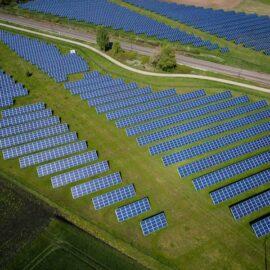Posted on Jun 10, 2022 by Hanna DuBuque
Renewable resources quickly replace fossil fuels, but do they depend on water? The short answer is yes. Renewable resources are dependent on the climate and its changes.
In a world where climate change is a hot topic, climate-independent power is needed. Weather-based energy sources like solar, wind, and hydropower constantly fail. However, that’s not to say other sources are any better. Nuclear power, for instance, is also suffering from climate change.
So, do renewable resources depend on the weather? And in what ways? Here’s all you need to know.
The Effect of the Climate on Solar Power Production
Solar power production is the power production sector most affected by the changing climate. While some weather changes positively influence this production, others can dampen it.
Positive weather influences include those caused by solar radiation. The more solar radiation a region gets, the more solar power production. This is a major benefit for communities with full solar and wants to get the most out of their investment.
But other events, such as storms, fires, and heavy winds, can cause major losses. It takes one hailstorm or hurricane to damage an expensive solar panel. And that’s not to even mention the effects of heatwaves. Too much heat lowers the efficiency of solar panels.
How Wind Farms Are Affected by the Weather
The wind turbine industry is no stranger to weather events. And the most dangerous of these is, ironically, high wind speeds. Intuitively, the higher the wind speed, the more the power production will be. However, if the power production goes beyond a certain power, the equipment can damage.
Most wind turbines turn off when wind speeds reach a certain critical threshold. Essentially, extreme wind speeds, especially with lots of changes in direction, can increase the load of the turbine. Additionally, the towers and blades withstand a certain wind speed level. When the wind blows faster than that, the structural integrity of the turbine is threatened.
And that’s not all.
If the turbine components have to move faster, they can wear out much quicker. And lastly, when the turbine keeps shutting off due to safety measures, the power output reduces.

Hydropower And the Water Cycle
Hydropower is the easiest form of renewable energy to maintain, with low operational costs. However, the biggest drawback of hydropower is its dependence on the weather and the water cycle.
The water or hydrologic cycle defines the movement of water from the ground to the sky and back down to the ground. It’s a natural way to recycle water. But changes in weather patterns can affect this cycle and hence hydropower facilities. Hydropower production is dependent on the precipitation that occurs in rivers. Water levels in reservoirs and dams also affect this type of power production.
There will be more power production with more precipitation and vice versa. However, the real problem comes when droughts strike a region, often leading to hydropower production dropping by up to 88%.
Temperature and Electricity Demand
One other way renewable energy sources are affected by the weather is on the demand side. When heat waves strike, there is a higher demand for electricity as more air conditioners and coolers are needed. Additionally, the cooling capacities lead to a drastic increase in the power load on power plants.
And the same happens when the temperature drops. As a result, consumption from air conditioners and refrigerators reduces, whereas the need for heaters increases. As a result, the power demand keeps on rising.
However, temperature is not the only factor that affects demand. Everything from water levels to wind speed decides how we consume electricity. For example, when there is lesser availability of water, coal and nuclear power plants suffer dramatically. And extreme wind also causes structural damage to distribution systems and transmission lines.
Nuclear Power and Climate Change
Since solar, wind, and hydropower plants all rely on weather events to function, you’d think they’re the only ones affected by climate change. But believe it or not, nuclear power is also dependent on how the weather is outside the plant.
These plants work because nuclear reactions are used to heat water into steam. This steam then turns a turbine which in turn generates electricity. The temperature is key to a nuclear power plant’s operation.
Past research already suggests that temperature affects the cooling processes of these plants. But newer research also suggests other effects the climate has on power plants.
Routine shutdowns are expected during typhoons and hurricanes. But these storms can also lead to clogging cooling pipes and full-blown nuclear power outages. Plus, storms and wildfires can cause significant structural damage. This affects production and can also be fatal to the surrounding area.
Such events can also lead to employee evacuations and dropping power production. And that’s not all. Extreme heat can lead to nuclear meltdowns and uncontrollable temperatures, with the same effect.
Conclusion
The changing climate is affecting our ability to use renewable resources. However, that doesn’t mean we should stop looking for friendlier alternatives to fossil fuels.
In a nutshell, almost all renewable power production methods are weather-dependent. Wind, solar, hydro, and even nuclear power plants get impacted by temperature, wind speed, hurricanes, and rainfall. Despite this, we are making a comeback in the form of better weather predictions and task force mobilization. If we can accurately prepare ourselves for unwanted weather events, we can undoubtedly fight climate change. In no time flat, we’ll be able to secure our power plants from nature’s worst disasters.




